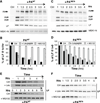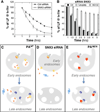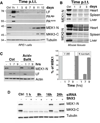Hijacking multivesicular bodies enables long-term and exosome-mediated long-distance action of anthrax toxin
- PMID: 24239351
- PMCID: PMC3866279
- DOI: 10.1016/j.celrep.2013.10.019
Hijacking multivesicular bodies enables long-term and exosome-mediated long-distance action of anthrax toxin
Abstract
Anthrax lethal toxin is a classical AB toxin comprised of two components: protective antigen (PA) and lethal factor (LF). Here, we show that following assembly and endocytosis, PA forms a channel that translocates LF, not only into the cytosol, but also into the lumen of endosomal intraluminal vesicles (ILVs). These ILVs can fuse and release LF into the cytosol, where LF can proteolyze and disable host targets. We find that LF can persist in ILVs for days, fully sheltered from proteolytic degradation, both in vitro and in vivo. During this time, ILV-localized LF can be transmitted to daughter cells upon cell division. In addition, LF-containing ILVs can be delivered to the extracellular medium as exosomes. These can deliver LF to the cytosol of naive cells in a manner that is independent of the typical anthrax toxin receptor-mediated trafficking pathway, while being sheltered from neutralizing extracellular factors of the immune system.
Copyright © 2013 The Authors. Published by Elsevier Inc. All rights reserved.
Figures







References
-
- Alouf JE, Freer JH, editors. The comprehensive sourcebook of bacterial protein toxins 3rd Edition. London: Academic Press; 2005.
-
- Baietti MF, Zhang Z, Mortier E, Melchior A, Degeest G, Geeraerts A, Ivarsson Y, Depoortere F, Coomans C, Vermeiren E, et al. Syndecan-syntenin-ALIX regulates the biogenesis of exosomes. Nature cell biology. 2012;14:677–685. - PubMed
-
- Baldari CT, Tonello F, Paccani SR, Montecucco C. Anthrax toxins: A paradigm of bacterial immune suppression. Trends Immunol. 2006;27:434–440. - PubMed
Publication types
MeSH terms
Substances
Grants and funding
LinkOut - more resources
Full Text Sources
Other Literature Sources

